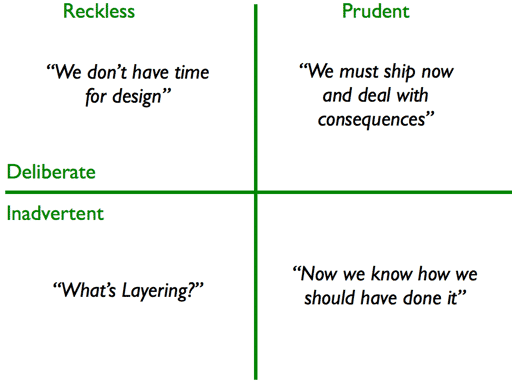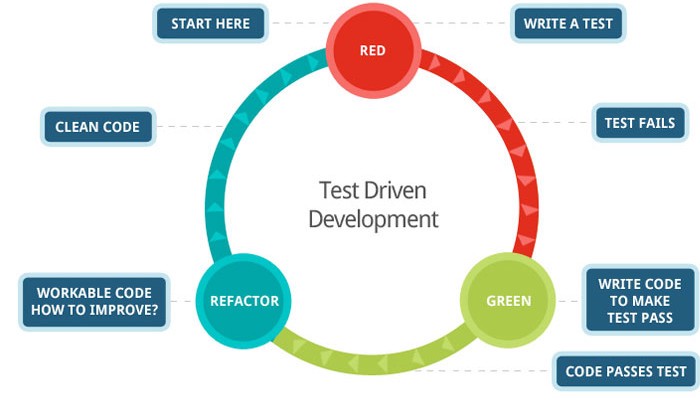Many businesses borrow money to accomplish things sooner than they might otherwise, but of course, they owe interest on the borrowed amount until repaid. Like borrowing money, rushing software out the door translates to shorter delivery times, but eventually, developers will need to go back and repay the technical debt by refactoring the code.
Let’s take a closer look at technical debt and four ways that you can minimize debt in enterprise projects.
Technical debt is a lot like financial debt—there are good and bad times to use it but it’s usually prudent to minimize it. Share on XWhat is Technical Debt?
Technical debt is the result of the trade-off between time and quality. When you prioritize rapid delivery over perfect code, you inevitably create future maintainability and upgradeability issues. That said, technical debt doesn’t necessarily mean poorly written code—it should ideally be focused on intentional and strategic decisions.
For example, suppose that a development team is tasked with creating an application with a narrow scope. Rather than taking the time to build a modular and extensible application, they might build the application to suit the immediate need. The technical debt in this case would be the extra effort required to modify the application to expand the scope in the future.
Like financial debt, technical debt isn’t necessarily good or bad. A startup may be willing to accrue technical debt to rapidly test a minimum viable product (MVP) since there’s no guarantee that the application will be commercially successful. On the other hand, enterprise projects may start a project knowing that it is going to be long-term and require new features.

The Technical Debt Quadrant - Source: Martin Fowler
The key to managing technical debt is ensuring that business and technical stakeholders understand the tradeoffs before making a decision. Of course, that process can be challenging since technical debt is less visible than financial debt. Businesses can also minimize unnecessarily technical debt by implementing some best practices.
Test-Driven Development
Test-driven development, or TDD, is the process of writing a test before writing any application code. That way, developers define a narrow scope based on a specification and can focus on writing as little application code as possible to pass the test. The process sidesteps the temptation to over engineer features and minimizes extraneous code.
In addition, the TDD process results in a test suite that can be automatically run before each code merge or deployment. Continuous integration and deployment processes can leverage these capabilities to minimize the number of defects that reach production users and help developers troubleshoot issues during a development cycle.
Going a step further, behavior-driven development, or BDD, can involve stakeholders in defining specific use cases. The BDD process reinforces collaboration between business and technical teams to ensure that everyone is on the same page, avoid costly rework and minimize the amount of technical debt accrued from misunderstandings.
Pair Programming
Pair programming is a process that involves two developers sharing a single workstation—either in-person or remotely—to improve code quality and consistency across a project. The developer at the keyboard, or the driver, is responsible for actually writing code while the navigator on the sidelines is responsible for the overall direction of the task.
While pair programming may seem unreasonably expensive to stakeholders, it can be a great way to bring new developers up-to-speed or help designers collaborate. Many organizations have found that pair programming actually saves money in the long run because higher quality code contains less errors and technical debt that would require rework in the future.
If pair programming is out of the question, thoughtful code reviews for each commit are a lighter option. Code reviewers should ensure that the code doesn’t contain any errors and strikes the right balance between delivery and quality.
Sufficient Refactoring Time
Refactoring is a critical strategy for minimizing technical debt, but unfortunately, there’s rarely time allocated to it within a development cycle. In essence, refactoring efforts are aimed at making an application more maintainable and extensible in the future. Allocating even a small amount of time to these tasks can pay big dividends in the future.
For example, a developer might extract similar code from two areas of an application into a new module that could be imported when needed. Any future updates can be made in one place rather than two (or more in the future) and any new parts of the application that require the module can easily import it rather than a developer rewriting it.

Red Green Refactor Process – Source: Tun Khine
If you’re using the TDD red-green-refactor process, you will naturally be refactoring as you progress through the development cycle. If you’re working with legacy software, you may want to allocate 30 minutes to refactoring every time you work on a specific piece of code. That way, the code base is constantly improving over time.
Well-Defined Processes
Test-driven development and refactoring are two technical solutions to minimize technical debt, but it’s equally important for business stakeholders to stick to a plan. While it’s always tempting to cut corners to accelerate a new feature, these efforts can quickly undermine and introduce technical debt into a project.
The best way to minimize these temptations is for business and technical teams to agree on a development process that is both structured and flexible. Business teams need some flexibility to respond to the market, but developers should know that they have the time required to product code at the right velocity and quality.
Agile and Scrum provide a great framework for guiding the development process. Stakeholders can prioritize user stories that developers estimate and pull into predictable one to four-week sprints. These processes create predictability for stakeholders when it comes to feature releases and developers when it comes to releasing new code.
The Bottom Line
Technical debt is similar to financial debt in that there’s a tradeoff between time and quality. In enterprise projects, it’s a good idea to minimize technical debt if projects are expected to stick around for a long time and/or require new features in the future. The good news is that there are some simple steps that you can take to minimize technical debt.
If you want to minimize technical debt, you may want to consider augmenting your development team to increase resources and make room for testing, refactoring and other efforts that can improve quality and maintainability. Sharkbyte offers team augmentation services with high-quality developers at a reasonable price.



